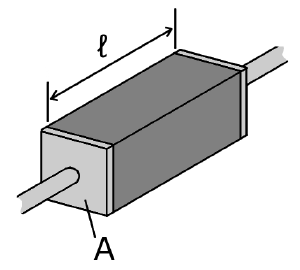Resistivity
Electrical resistivity (also known as specific electrical resistance) is a measure of how strongly a material opposes the flow of electric current. A low resistivity indicates a material that readily allows the movement of electrical charge. The SI unit of electrical resistivity is the ohm meter.
Definitions
The electrical resistivity ρ (rho) of a material is given by
where
- ρ is the static resistivity (measured in ohm meters, Ωm);
- R is the electrical resistance of a uniform specimen of the material (measured in ohms, Ω);
- is the length of the piece of material (measured in meters, m);
- A is the cross-sectional area of the specimen (measured in square meters, m²).
Electrical resistivity can also be defined as
where
- E is the magnitude of the electric field (measured in volts per metre, V/m);
- J is the magnitude of the current density (measured in amperes per square meter, A/m²).
Finally, electrical resistivity is also defined as the inverse of the conductivity σ (sigma), of the material, or
Table of resistivities
This table shows the resistivity and temperature coefficient of various materials. The values are correct at 20 °C (68 °F)
{{#invoke:Message box|ambox}}
| Material | Resistivity (Ωm) | Coefficient* |
|---|---|---|
| Silver[1] | 1.59×10−8 | .0038 |
| Copper[1] | 1.7×10−8 | .0039 |
| Gold[1] | 2.44×10−8 | .0034 |
| Aluminum[1] | 2.82×10−8 | .0039 |
| Tungsten[1] | 5.6×10−8 | .0045 |
BrassCite error: The opening <ref> tag is malformed or has a bad name |
0.8×10−7 | .0015 |
| Iron[1] | 1.0×10−7 | .005 |
| Platinum[1] | 1.1×10−7 | .00392 |
| Lead[1] | 2.2×10−7 | .0039 |
| Manganin[2] | 4.82×10−7 | .000002 |
| Constantan[2] | 4.9×10−7 | |
| Mercury[2] | 9.8×10−7 | .0009 |
| Nichrome[1][3] | 1.10×10−6 | .0004 |
| Carbon[1][4] | 3.5×10−5 | -.0005 |
| Germanium[1][4] | 4.6×10−1 | -.048 |
| Silicon[1][4] | 6.40×102 | -.075 |
| Glass[1] | 1010 to 1014 | ? |
| Hard rubber[1] | approx. 1013 | ? |
| Sulfur[1] | 1015 | ? |
| Paraffin | 1017 | ? |
| Quartz (fused)[1] | 7.5×1017 | ? |
| PET | 1020 | ? |
| Teflon | 1022 to 1024 | ? |
*The numbers in this column increase or decrease the significand portion of the resistivity. For example, at 21°C (294.15 K), the resistivity of silver is 1.65×10−8.
Temperature dependence
In general, electrical resistivity of metals increases with temperature, while the resistivity of semiconductors decreases with increasing temperature. In both cases, electron-phonon interactions can play a key role. At high temperatures, the resistance of a metal increases linearly with temperature. As the temperature of a metal is reduced, the temperature dependence of resistivity follows a power law function of temperature. Mathematically the temperature dependence of the resistivity ρ of a metal is given by the Bloch-Gruneissen formula :
where is the residual resistivity due to defect scattering, A is a constant that depends on the velocity of electrons at the fermi surface, the Debye radius and the number density of electrons in the metal. is the Debye temperature as obtained from resistivity measurements and matches very closely with the values of Debye temperature obtained from specific heat measurements. n is an integer that depends upon the nature of interaction:
- n=5 implies that the resistance is due to scattering of electrons by phonons (as it is for simple metals)
- n=3 implies that the resistance is due to s-d electron scattering (as is the case for transition metals)
- n=2 implies that the resistance is due to electron-electron interaction.
As the temperature of the metal is sufficiently reduced (so as to 'freeze' all the phonons), the resistivity usually reaches a constant value, known as the residual resistivity. This value depends not only on the type of metal, but on its purity and thermal history. The value of the residual resistivity of a metal is decided by its impurity concentration. Some materials lose all electrical resistivity at sufficiently low temperatures, due to an effect known as superconductivity.
An even better approximation of the temperature dependence of the resistivity of a semiconductor is given by the Steinhart-Hart equation:
where A, B and C are the so-called Steinhart-Hart coefficients.
This equation is used to calibrate thermistors.
Complex resistivity
When analyzing the response of materials to alternating electric fields, as is done in certain types of tomography, it is necessary to replace resistivity with a complex quantity called impeditivity, in analogy to electrical impedance. Impeditivity is the sum of a real component, the resistivity, and an imaginary component, the reactivity (reactance) [1].
Sources
- ↑ 1.00 1.01 1.02 1.03 1.04 1.05 1.06 1.07 1.08 1.09 1.10 1.11 1.12 1.13 1.14 1.15 Serway, Raymond A. (1998). Principles of Physics, 2nd ed, Fort Worth, Texas; London: Saunders College Pub, p602. ISBN 0-03-020457-7.
- ↑ 2.0 2.1 2.2 Giancoli, Douglas C. (1995). Physics: principles with applications, 4th ed, London: Prentice Hall. ISBN 0-13-102153-2.
(see also Table of Resistivity) - ↑ Ni,Fe,Cr alloy commonly used in heating elements.
- ↑ 4.0 4.1 4.2 The resistivity of semiconductors depends strongly on the presence of impurities in the material.
- Paul Tipler (2004). Physics for Scientists and Engineers: Electricity, Magnetism, Light, and Elementary Modern Physics (5th ed.). W. H. Freeman. ISBN 0-7167-0810-8.
See also
- Electrical conductivity
- Electrical resistivity imaging
- SI electromagnetism units
- Sheet resistance
External links
- http://www.facstaff.bucknell.edu/mastascu/eLessonsHTML/Sensors/TempR.html
- http://www.trekinc.com/pdf/1005_Resistivity_Resistance.pdf








